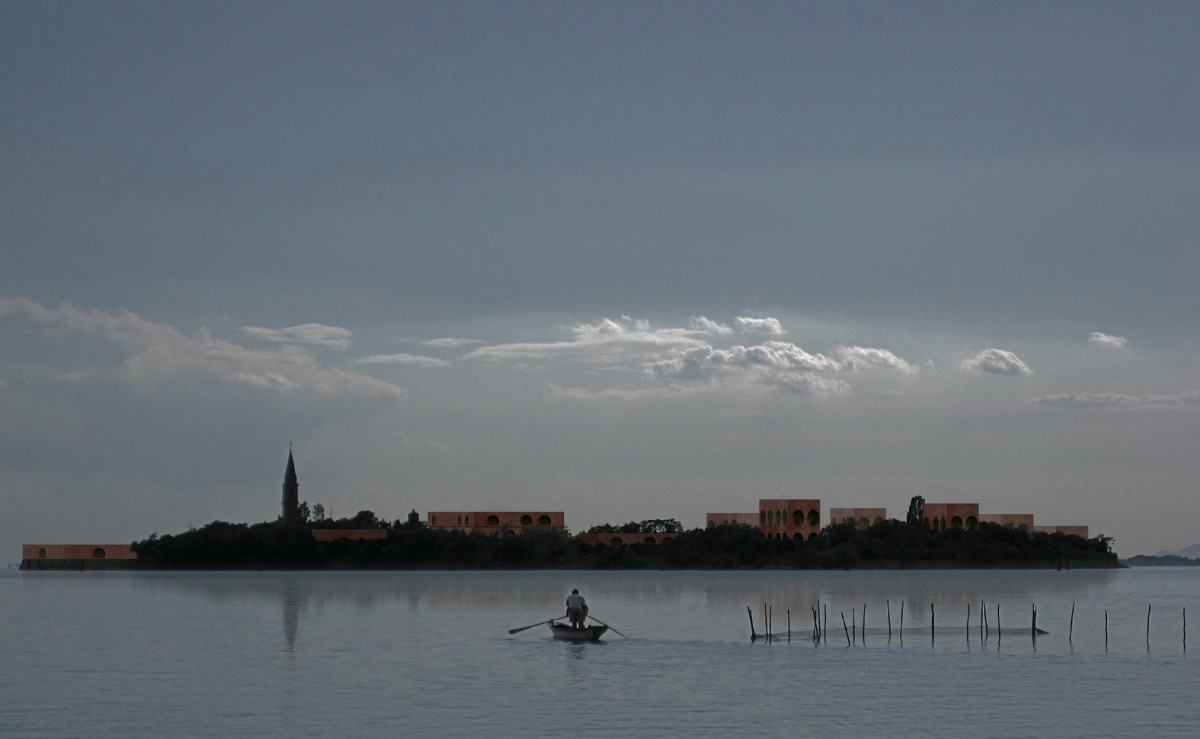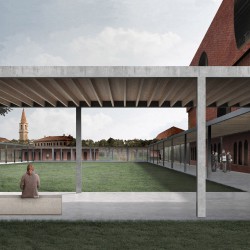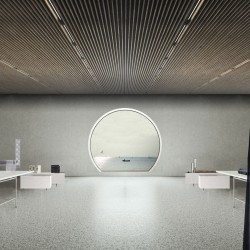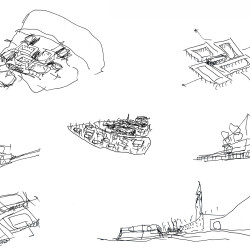Lapo Ruffi . Vanessa Giandonati
In part of the lagoon, to the south of Venice extending toward Lido, there was a island, Poveglia: “marvelously imitated rock … rays of the sun … landscape”, these ones are all significant element of the site, in the same way as they were for Marcantonio Michiel at the sight of Three philosophers of Giorgione’s painting in the house of Taddeo Contarini in Venice. The proposal for the new campus is materialized through a green park of monumental landmarks which welcomes knowledge place, where new architectures are surrounded by nature, one on top of the other interconnected by a network of linked and continuous courtyards. So can be seen the new Poveglia, pars pro toto, as the emblem of a process of continuing growth and reinvention of the Venetian forma urbis.
_
Architectures surrounded by nature, fragments like new ruins, such as tangent volumes to horizontal green breaks, circumscribe the new courtyards: elements almost disappeared today except in the gardens of the convents. These structures, mindful of the Venetian lagoon garden, hortus conclusus of medieval origins, whose form reflects the urban system of the insulae, welcome the new places of “delizie”. An architecture capable of preserving the richness and uniqueness of the place while revealing unexpected landscapes that each hides.
So the project borrows and alters the organization of knowledge space in courtyards, which gain porticoes that grouping of autonomous parts remains and is even accentuated: classrooms, laboratories, university offices, student housing and sport facilities, as specific functions they have a value within the island; auditorium hall, library and reading room, canteen and exhibition spaces, as architectures from most resonance within the campus which nevertheless can accommodate events from the nearby Venice as elements of representation and reception.
Therefore the ability to tell an unit through the use of fragments, where the fragment becomes the guardian of primordial unit and it is contemporaneously opposed to it, vary and, at the same time, redefine the landscape of Poveglia, between contemporary and tradition. Fragments, like devices, full masses to accommodate specific functions, like the Octagon, exhibition place, or hollow masses, where to stop, rest or simply marvel, like in the courtyards: geometrical green breaks adjacent to the architectures. The vision of the viewer will be catalyzed by the isolated architecture, pavilions or courtyards, where “space is not the environment in which things have, but the means by which even the position of things becomes possible” (Robert Morris).
The campus typology is based on the principles of the courtyard and is composed of various pavilions, existing or new, both with green spaces featured strongly: an almost wild nature on the island edges alternates with more regulated internal geometries where to accommodate the pleasure gardens, wild thickets or simple breaks into the green, like contemplation places.
A new covered distribution system, which externally links all the main buildings in the complex of the campus, is generated by the functional recovery and conservation of existing volumes, and building additional volumes for the insertion of new spaces required by the program. The planimetric solution not only allows to connect more effectively the pavilions, but also generate a new meeting place that encourages educational relationships within the campus.
The space created by this shelter, as memory of sotopòrtego wood, defines, finally, a hierarchy of outdoor spaces, identifying and organizing spaces for recreation and sports areas, in addition to those for learning area, study and exhibition. Therefore the courtyards system, like as internal generator system, becomes the central public meeting place for students, staff, scientists and professors to share ideas or socialize. While towards the edges of the island, the architectures, the monolithic red brick volumes which observe the lagoon through large “oci”, stops of a visual journey, in a fruitful isolation with multiple looks towards the world.
_
YAC | University Island
FRAGMENTS LIKE NEW RUINS
Honorable mention
Architects
Lapo Ruffi, Vanessa Giandonati
Collaborators
Nicholas Diddi
Client
Young Architects Competitions
Site
Poveglia Island, Venice, Italy
Site area
123,500 m²
Competition Phase
03.2016 – 06.2016











Comments are closed.